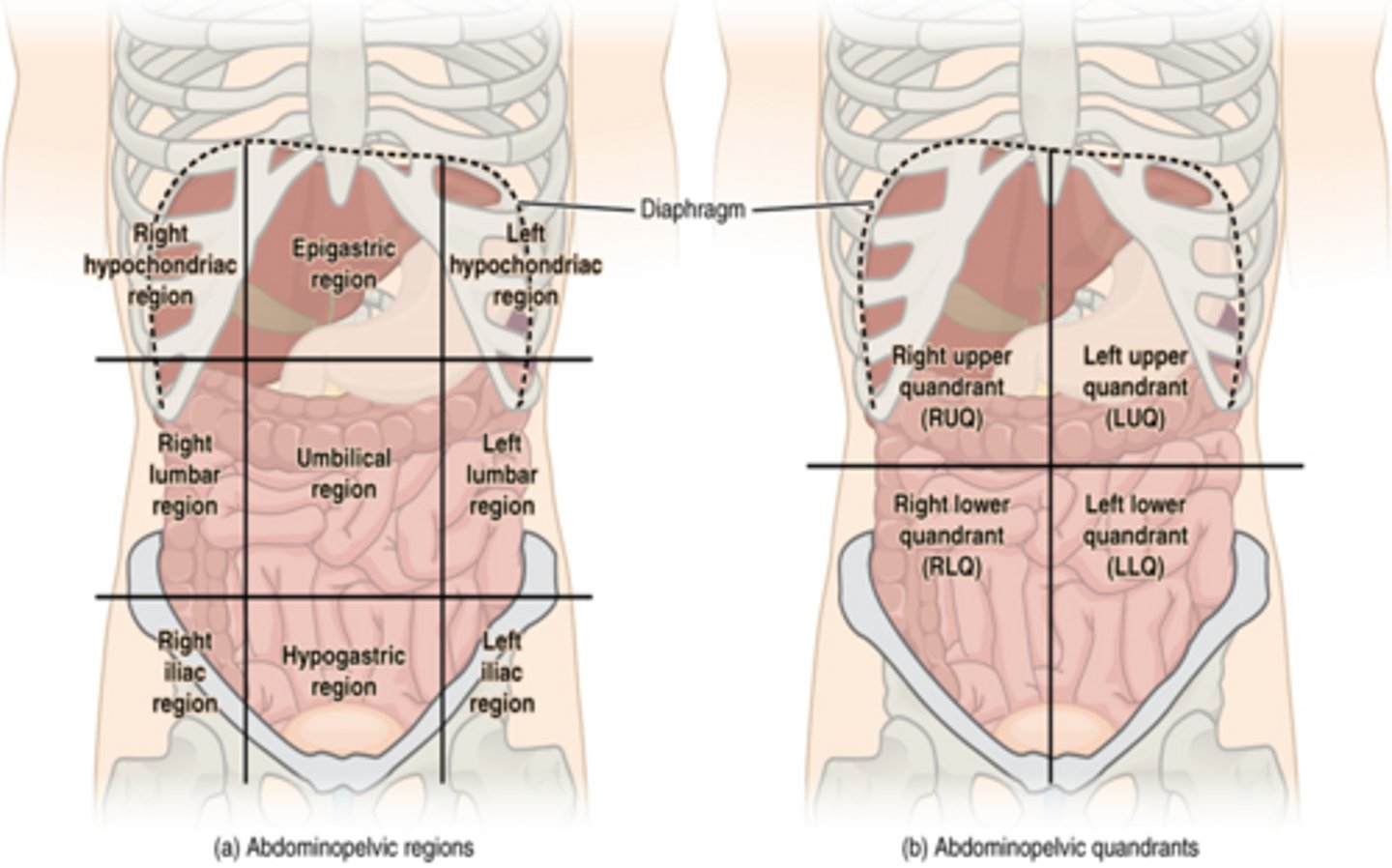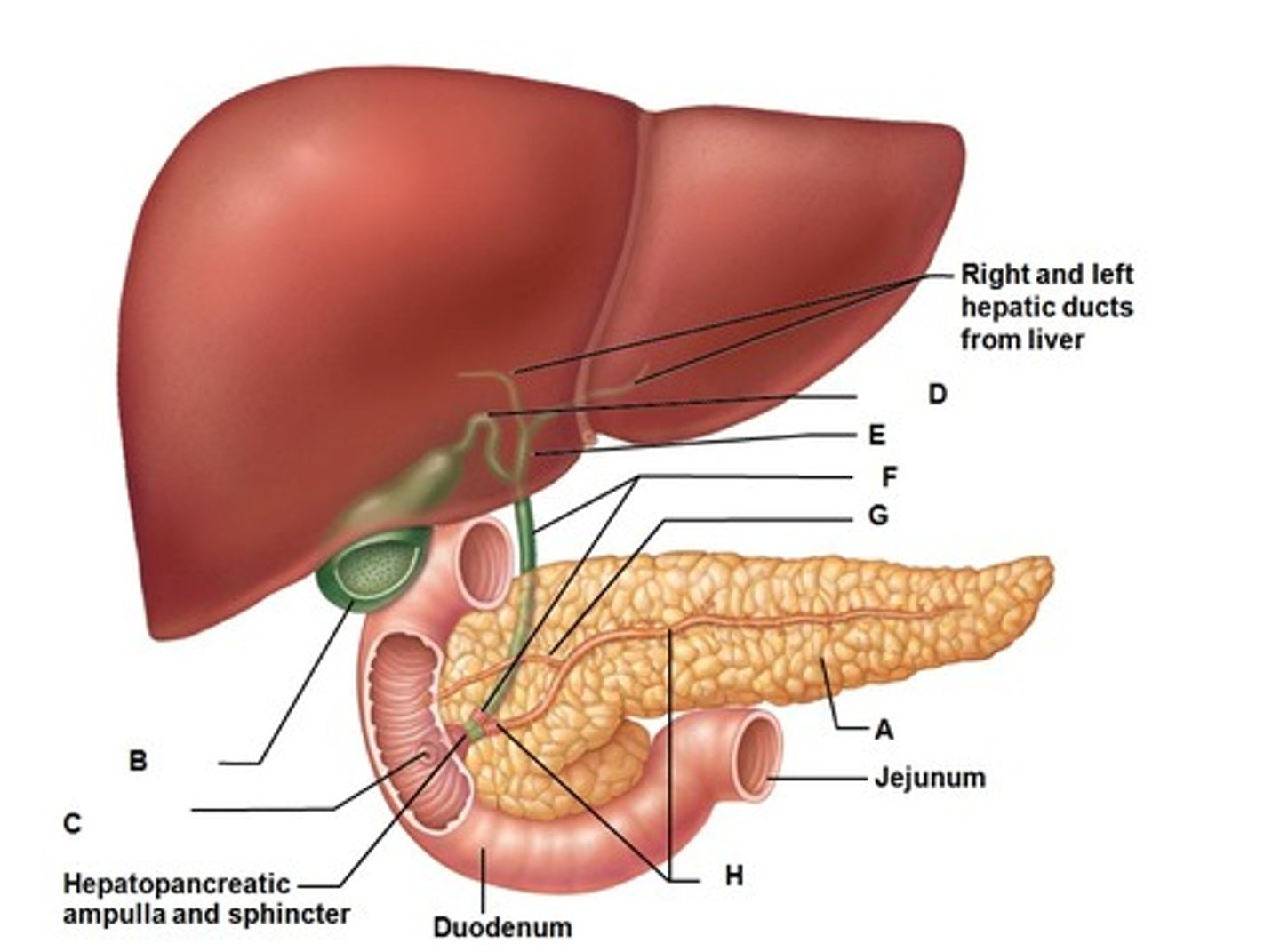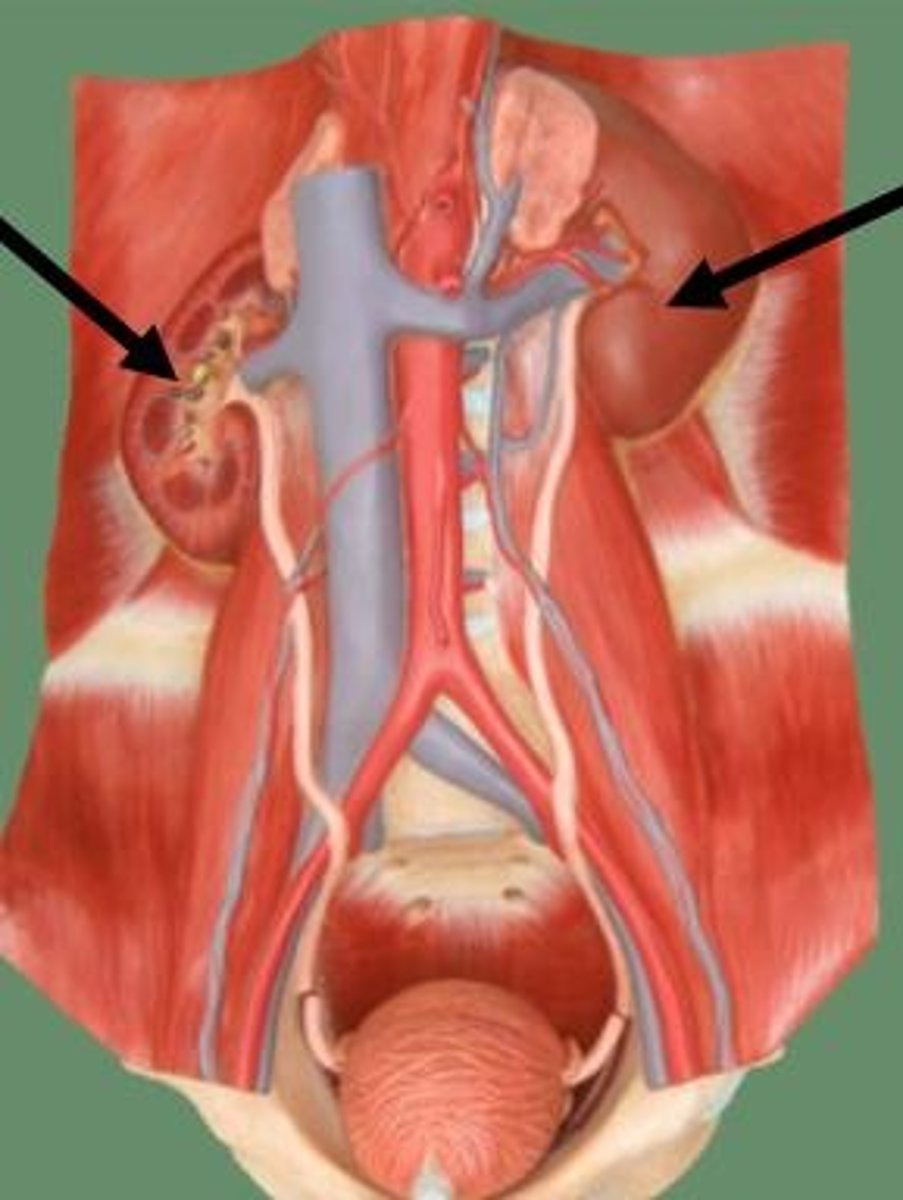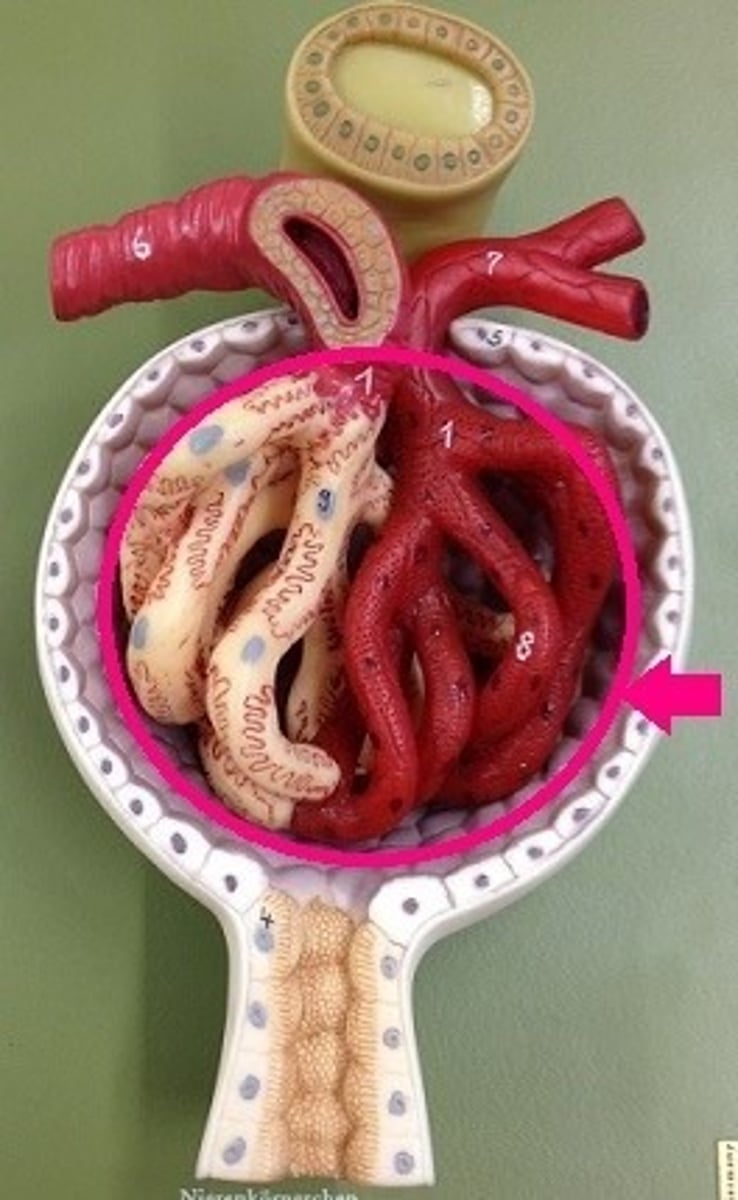ch.12 pt 2
1/49
There's no tags or description
Looks like no tags are added yet.
Name | Mastery | Learn | Test | Matching | Spaced |
|---|
No study sessions yet.
50 Terms
liver
Second to the brain, the ______ is the largest organ and performs the most functions
the liver metabolizes
carbohydrates, proteins, and fats to keep energy levels consistent.
liver primary role
to store glucose as glycogen and collect fat-soluble vitamins and iron for future use
where is the liver located
upper-right quadrant (URQ)
• Under the diaphragm, above the stomach, and right of the pancreas.

Glisson's capsule (similar to pericardium of heart)
• Tough capsule surrounding the liver
• Protects the parenchyma (functioning tissue of the organ).
• Damage to liver is referenced to amount of damage to this capsule
gall bladder
• Located under liver and work together to store and process fats indigestion.

Injury to the liver can present in referred pain to the right shoulder or as an acute, sharp pain over the organ, depending on the area of injury
true
the liver has the abilily to
regenerate
• A small but healthy portion of a liver will grow and adapt to the size of the host and reassume all usual functions.
Where is the spleen located
Upper-left quadrant (ULQ) und the left lower rib cage
Pregnancy, mononucleosis, or other blood disorders inflame the spleen
true
Spleen is not fully protected by the _______ in children
ribs
main function of the spleen
Filtering blood and supplying antibodies
One can live without a spleen; marrow of long bones and certain glands will take over the majority of its functions
true
Highly vascular organ
At any time holds 5%-6% of cardiac output while filtering 10% to 15% of total blood volume per minute.
Liver injury overview
Potentially life threatening•
MOI: Blunt force•
Primary complaint: "Wind knocked out of me"•
Can rapidly deteriorate from internal bleeding and shock
spleen injury overview
Potentially life threatening
• MOI: Blunt force; may seem like trivial contact
• Pain is often referred to upper-left shoulder (Kehr's sign)
risk factors of spleen and liver injury
• History of hepatic conditions
• Participation in American football and lacrosse
• Pregnancy, infectious mononucleosis, and some blood disorders (can enlarge spleen)
Liver injury symptoms
-Sharp URQ pain that may radiate to the right shoulder
• Signs may be subtle at first, but reevaluation is paramount
• Nausea and vomiting are not unusual
• Immediate Transfer is needed when:
• Anxiety, dyspnea, pale and sweaty skin, and confusion (all are signs of shock)
spleen injury symptoms
• Wind knocked out with vague abdominal pain/distress to follow
• Pain on lower-left ribs and ULQ, abdominal guarding, swelling, and muscle spasm, nausea, and urge to defecate.
• Signs of shock include: thready pulse, pale and sweaty skin, and lowering blood pressure
American Association for the Surgery of Trauma (AAST) Grading System
Grade 1-6
Grade l
Subcapsular hematoma with less than 10%surface area involved
Grade ll
Capsular tear less than one centimeter
Grade lll
Subcapsular hematoma of 10%-50% in surfacearea
Grade VI
Where the hepatic artery is avulsed
Grades I-V
correspond with increasing challenges in liver damage; grade VI is fatal
immediate management for spleen/liver injuries
Critical management/treatment: Patients that present with dyspnea and who are pale, tachycardic, and hypotensive
immediate management for spleen/liver injuries continued
Once athlete is removed from play, all that can be done is monitor vitals and activate EMS
• Place patient in hook-lying position
• Provide supplemental oxygen (12-15 L/min via non-rebreather) as precaution for shock• If injury is suspected, patient must be transferred to hospital
Kidneys
Located outside the peritoneal cavity, along the lower thoracic spine and largely under the final ribs
.• Attached to the diaphragm and move slightly with breathing

Kidneys primary function
Maintain homeostasis through maintaining fluid balance, removing waste from blood and regulating both blood pressure and red blood cells in the body
Kidneys are highly vascular organs and are vital in urine production
true
Hematuria
blood in the urine
• Possible sign of kidney trauma

MOi for kidneys
Direct blow to the lower posterior rib cage can injure a kidney
Posterior back plate
can help prevent kidney injury•
Does require a tight fitting jersey to cover the pad and firmly secure it to the body
Kidney is ______% of all abdominal trauma
3%
Only risk factor for kidney trauma is participation incollision/contact sport.
true
signs/symptoms of kidney inury
• Painful breathing, dyspnea, tachycardia, and later hypotension
• Can also include nausea, dizziness, and abdominal pain
• Extremely painful injury
• Hematuria post practice/game (delayed sign)
• Idiopathic hematuria
• Dehydration
• Foot-strike hemolysis
• Nonsteroidal anti-inflammatory drugs (NSAIDs)
• Hypoxic kidney damage
• Increased circulation rate
• Myoglobinuria release
Blow to the _______or flank area is suspicion of kidney injury
posterior lower ribs
When assessing for kidney injury
Inspect for visible sign of injury (not likely); palpation of the area will help in assessment
Injury is graded similarly to kidney and spleen classification(AAST)
• Grades II-V each have larger tears and advancing detrimental urinary sequelae
true
Transport if patient is deteriorating or hemodynamically unstable for kidney injury
true
kidney stones
Salts crystalizing within the ureters, urinary bladder, or urethra,often forming a blockage
signs and symptoms of kidney stones
sudden acute pain, hematuria, nausea, and vomiting
• Abdominal sounds are normal
• If symptoms are accompanied by a fever, refer immediately
Acute kidney stones can create pain on either side of the back(either ureter), over the pubis (bladder,) or anywhere along the urethra
true
Once the stone passes, the patient is usually free of symptoms but may have residual _______from the stone scraping or stretching the urethra.
hematuria
appendix
Formally known as vermiform appendix
where is the appendix located
Located in the LRQ at the juncture of the small and large intestines
• Not firmly attached to anything which creates a challenge to palpate or elicit pain when palpated in a specific spot.
the appendix lies in the peritoneum and tends to have referred or diffuse pain instead of pain directly over the organ
true
McBurney's point
the location and special test to determine an injury
Appendicitis
• Not brought on by trauma
• Inflammation of the appendix
• If appendix ruptures, patient can become septic, which can be fatal
signs and symptoms of Appendicitis
Vomiting and unspecific abdominal pain•
McBurney's point: Rebound pain
• Rovsing's sign: RLQ pain when palpating LLQ
• Dunphy's sign: Right-sided abdominal pain, which can be associated with coughing